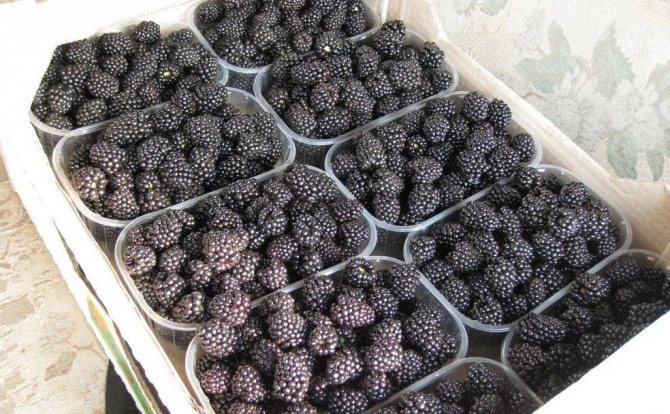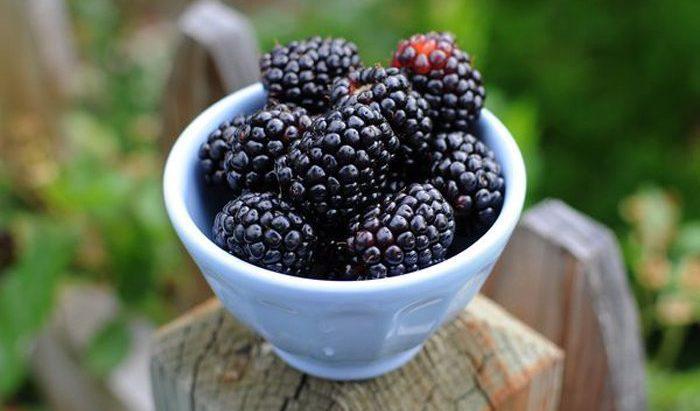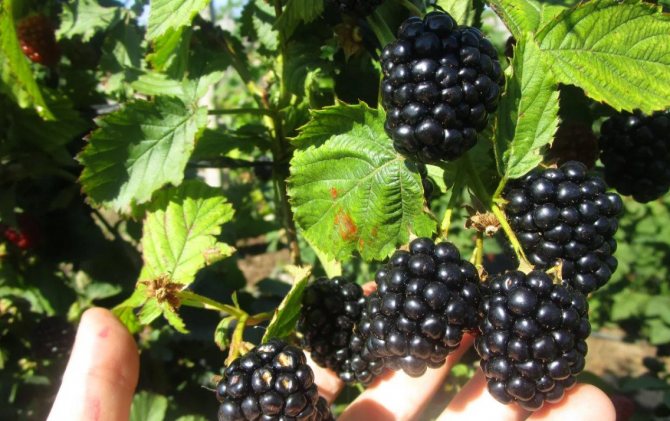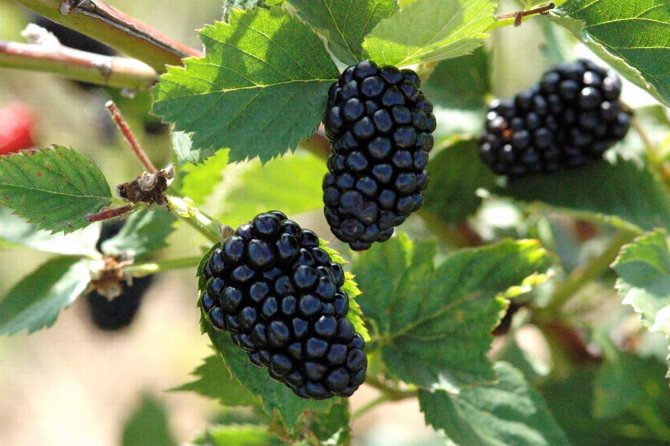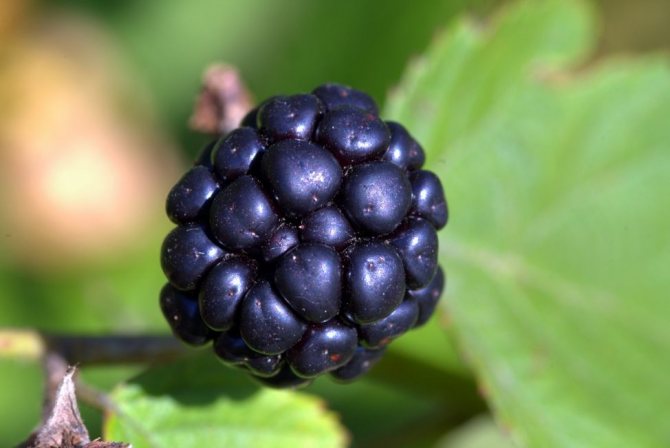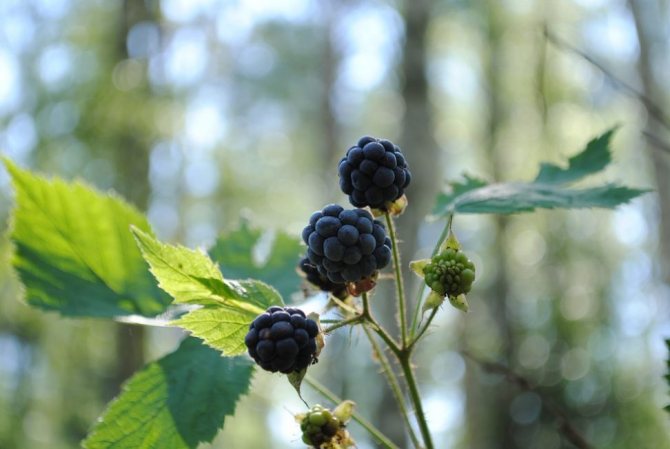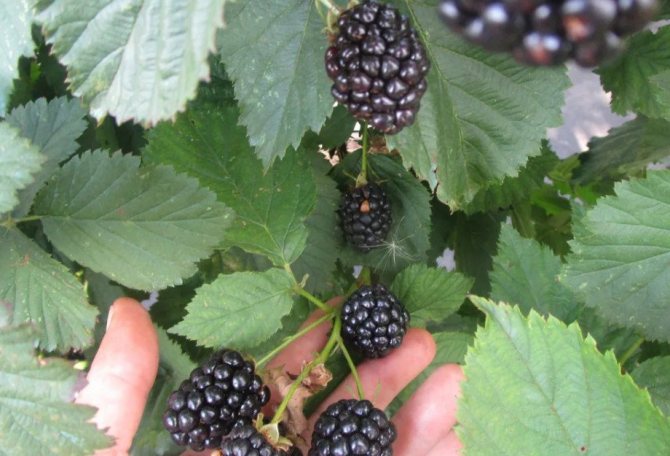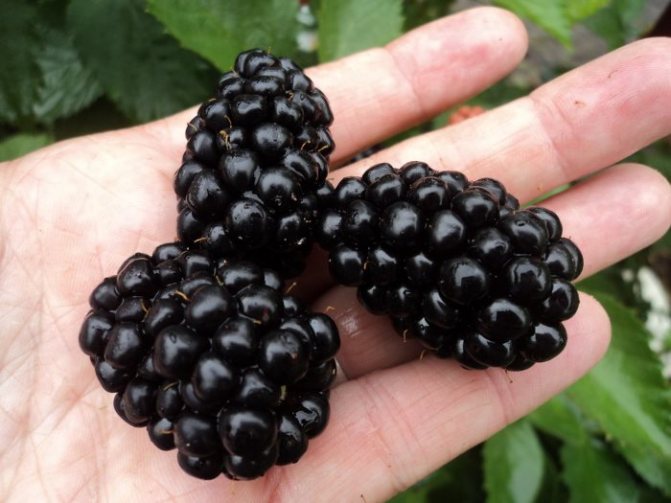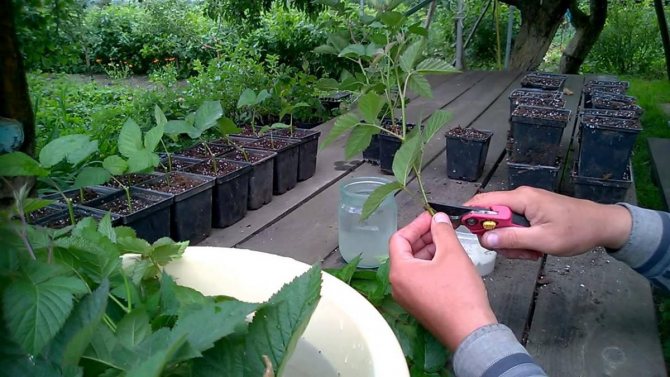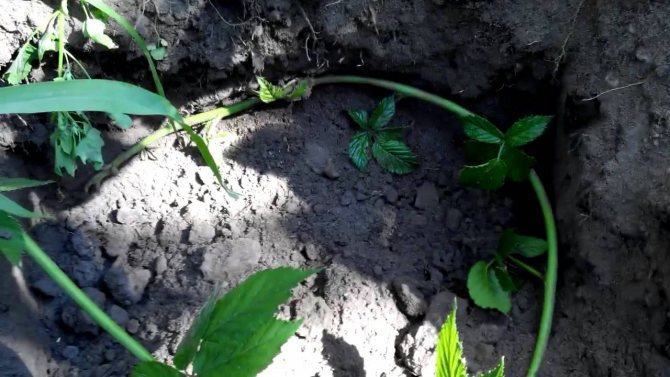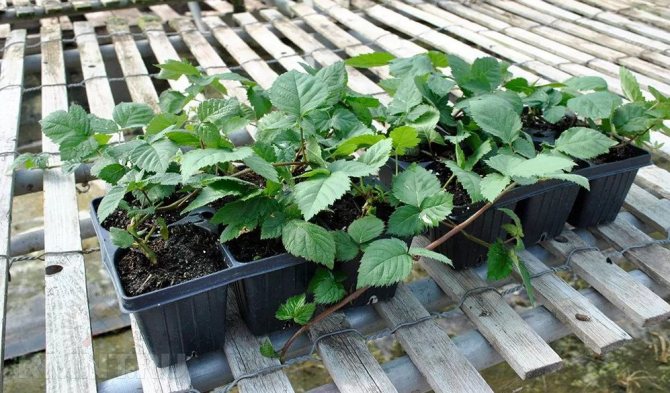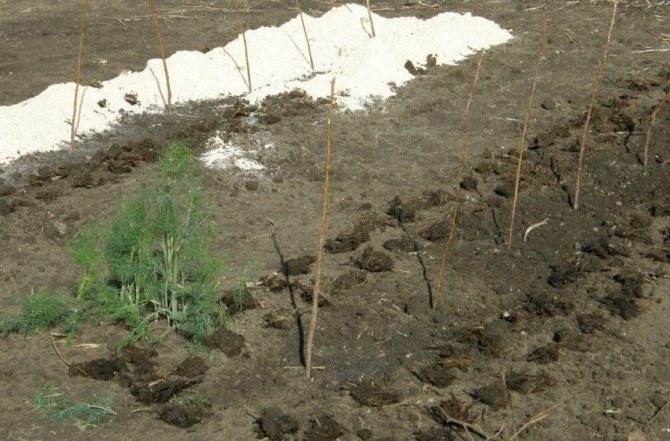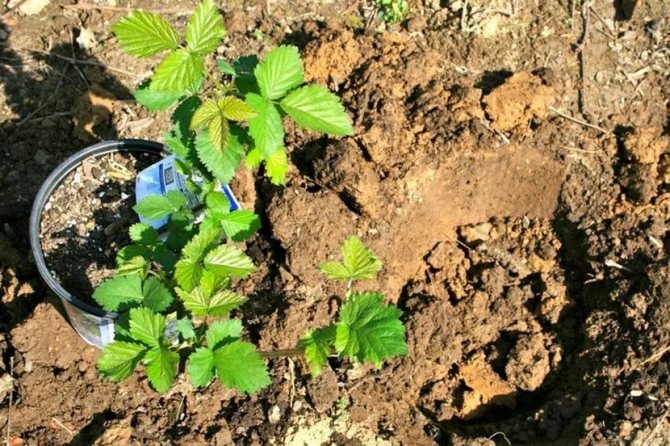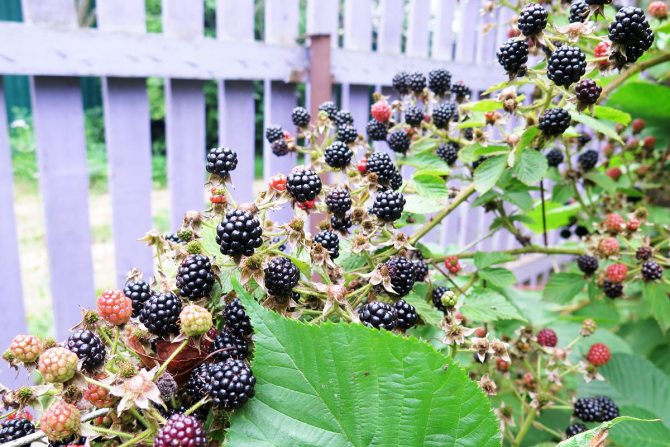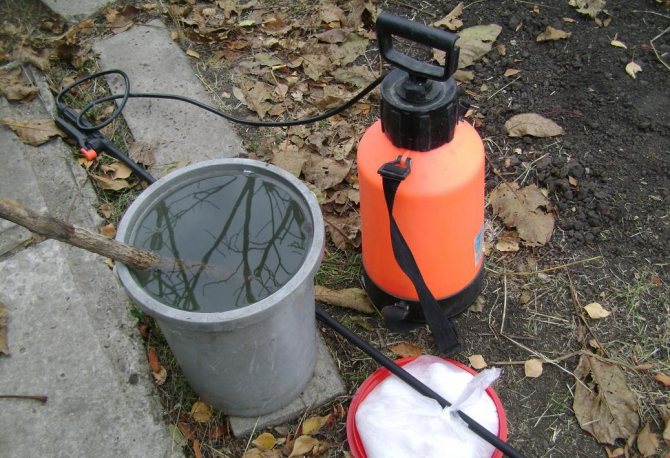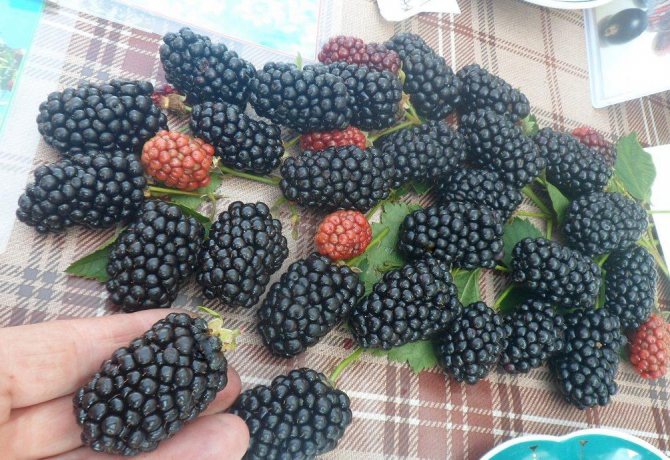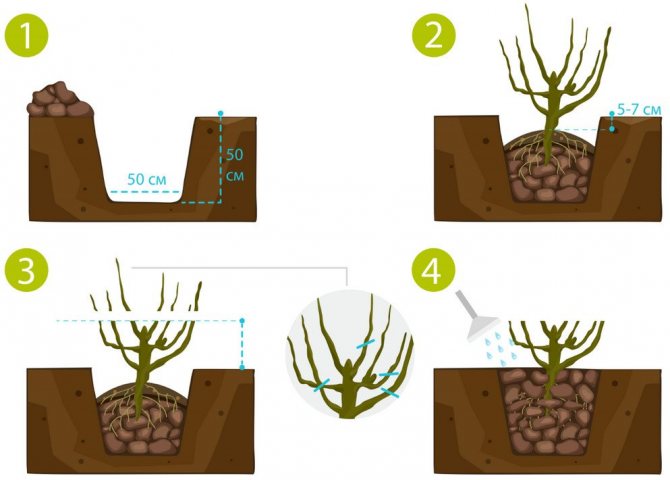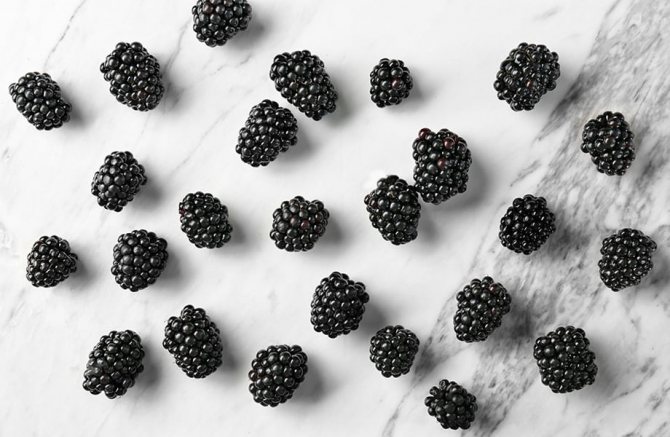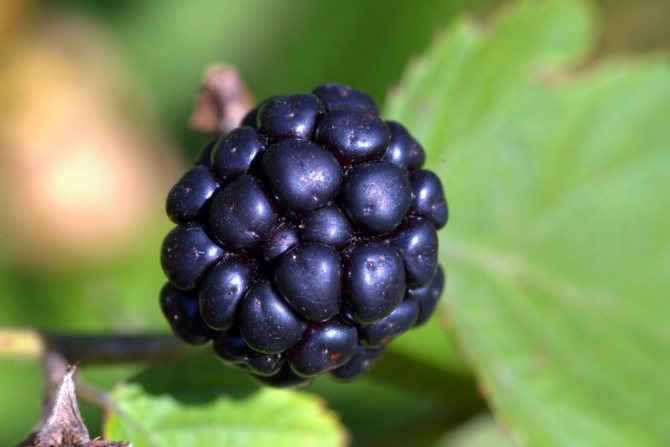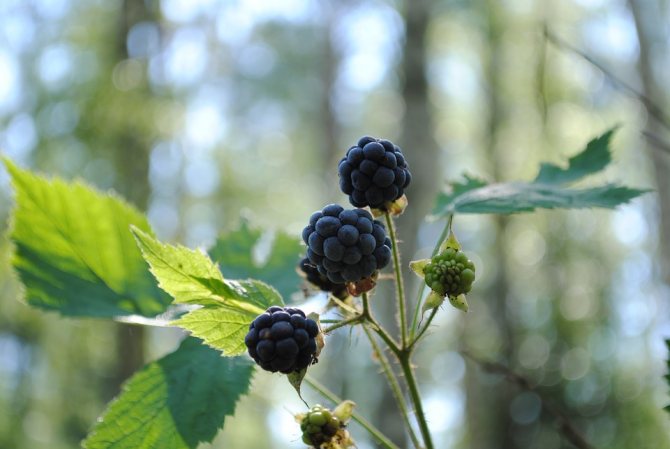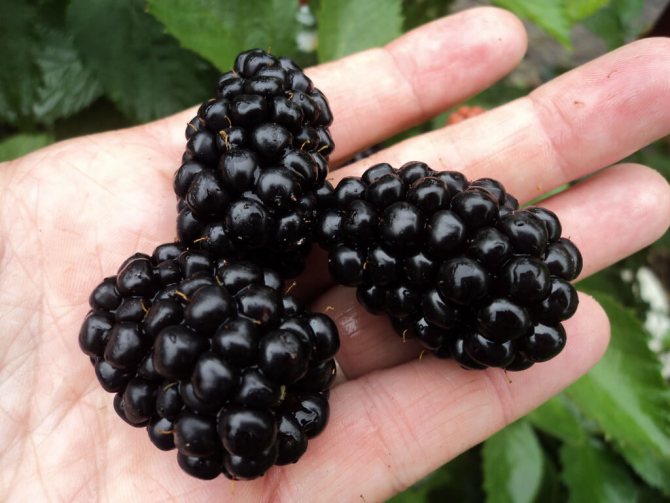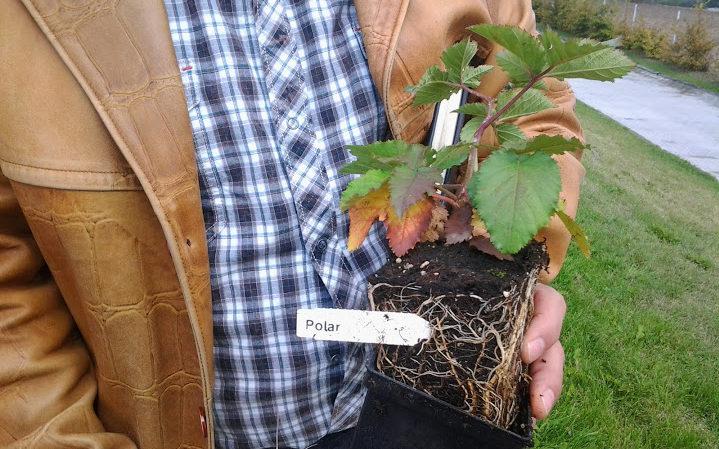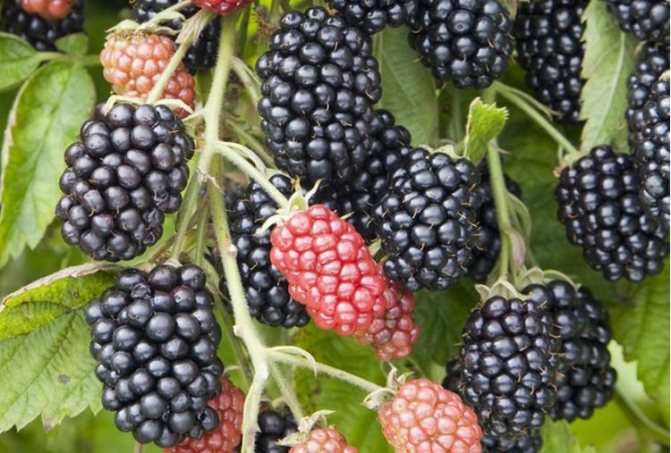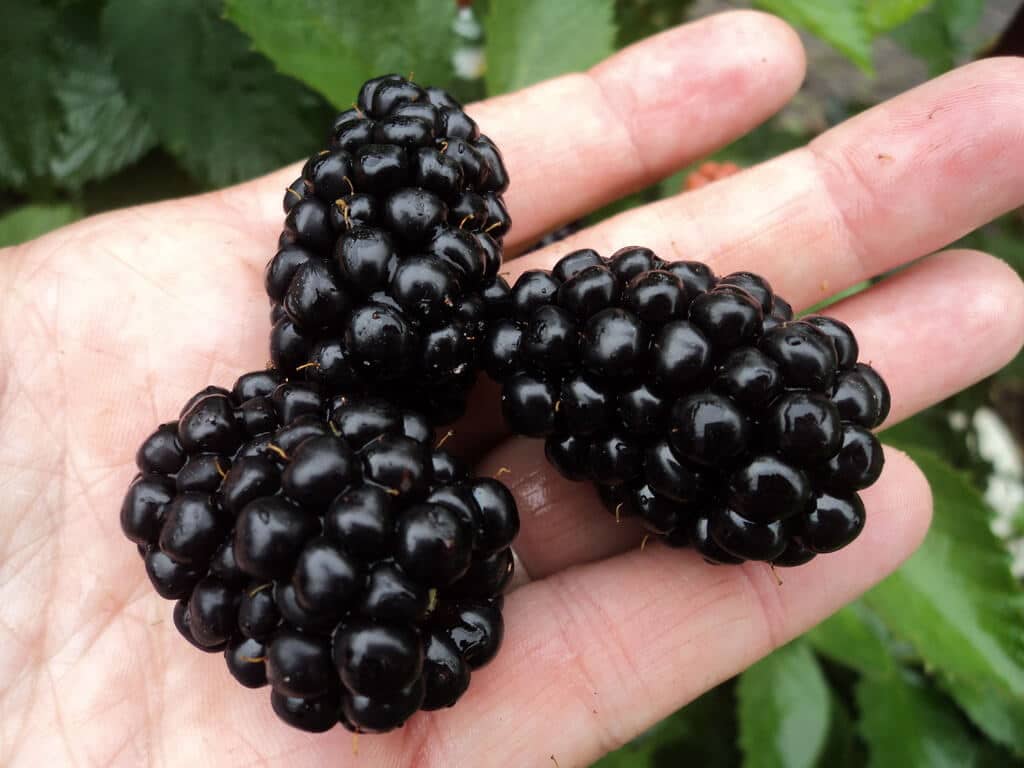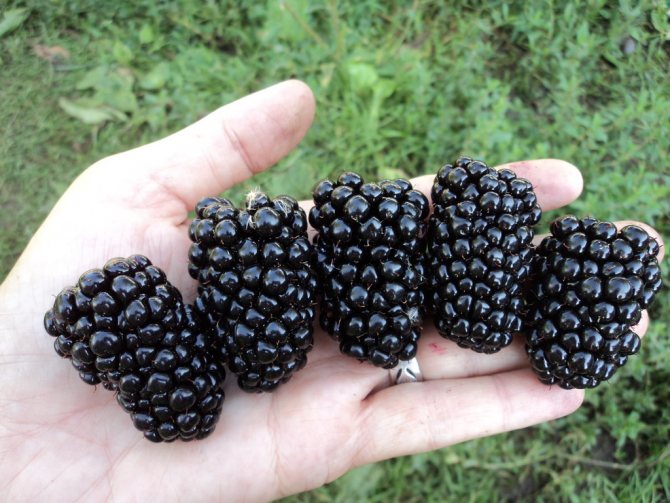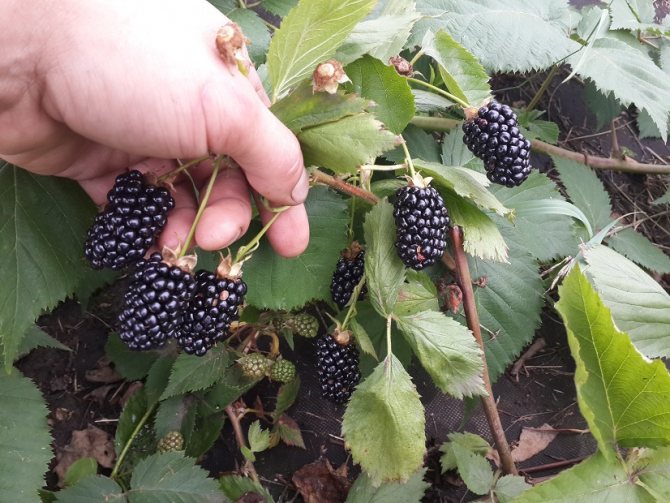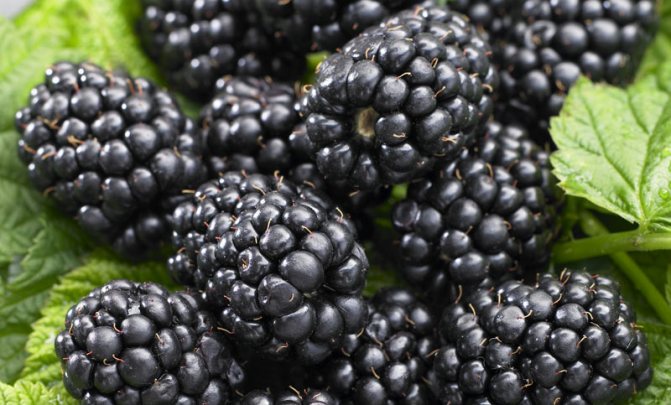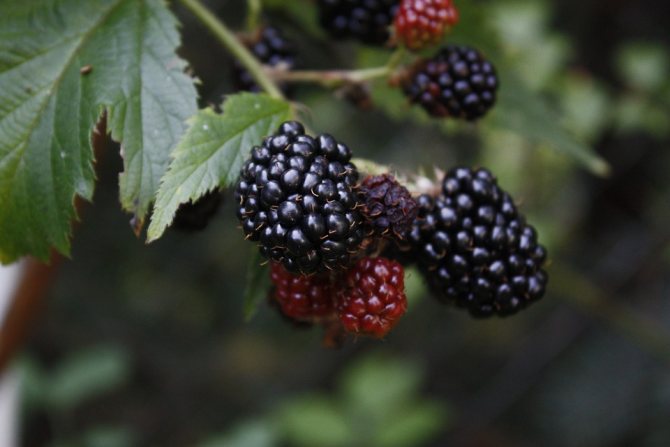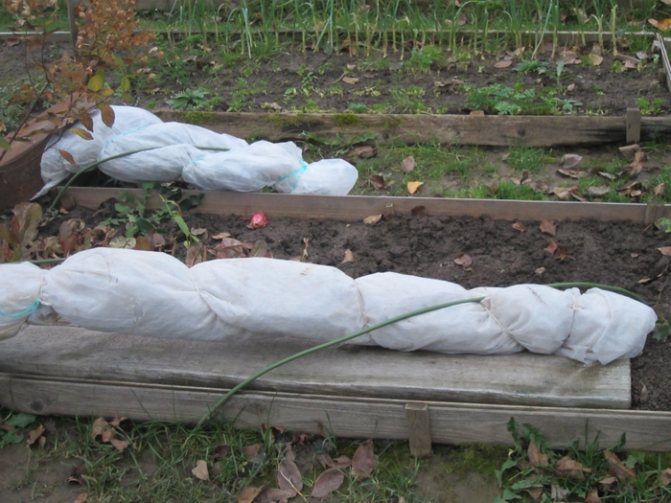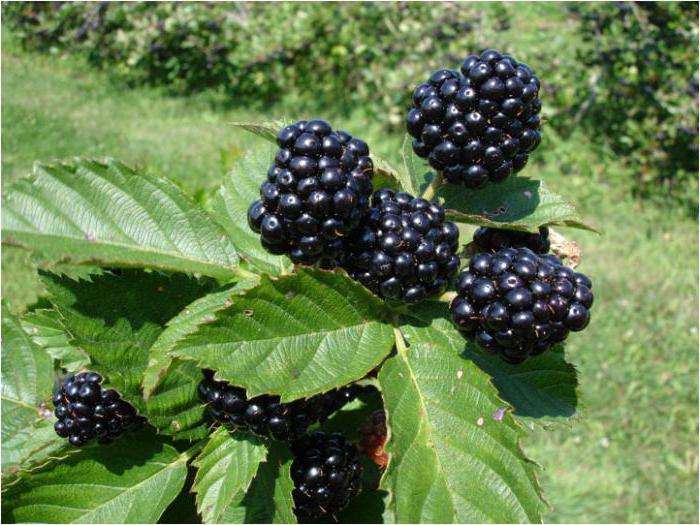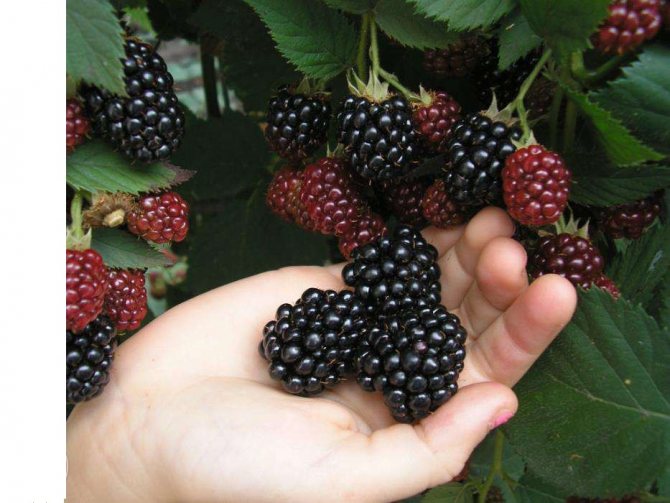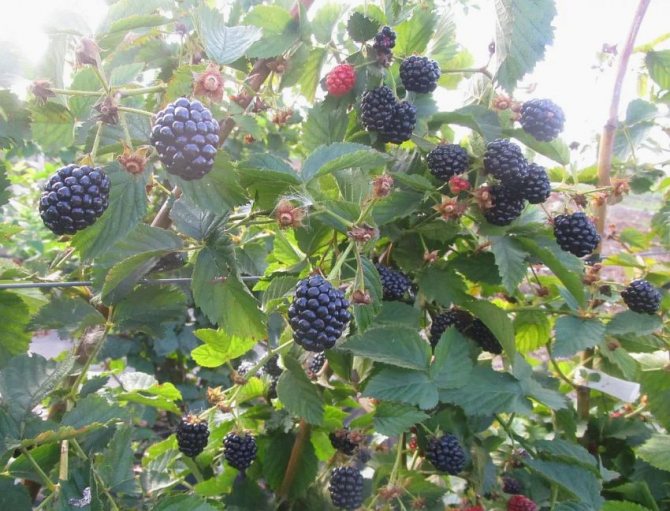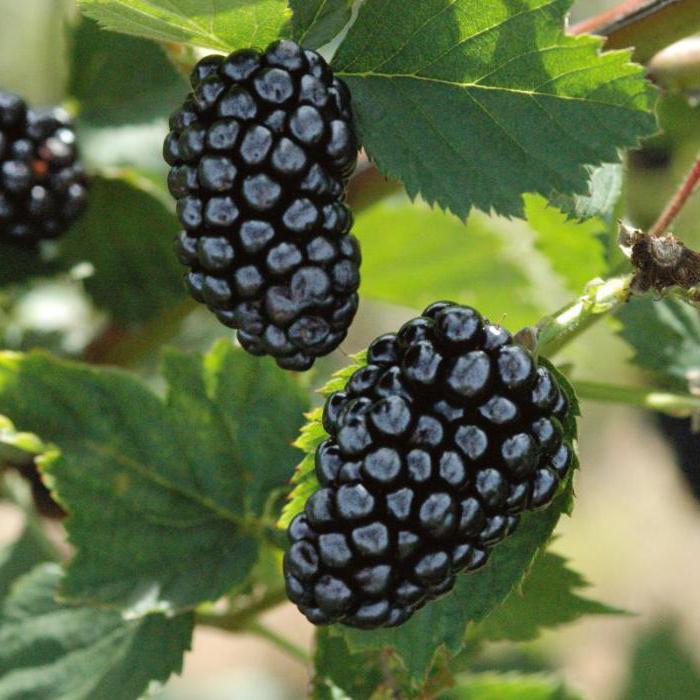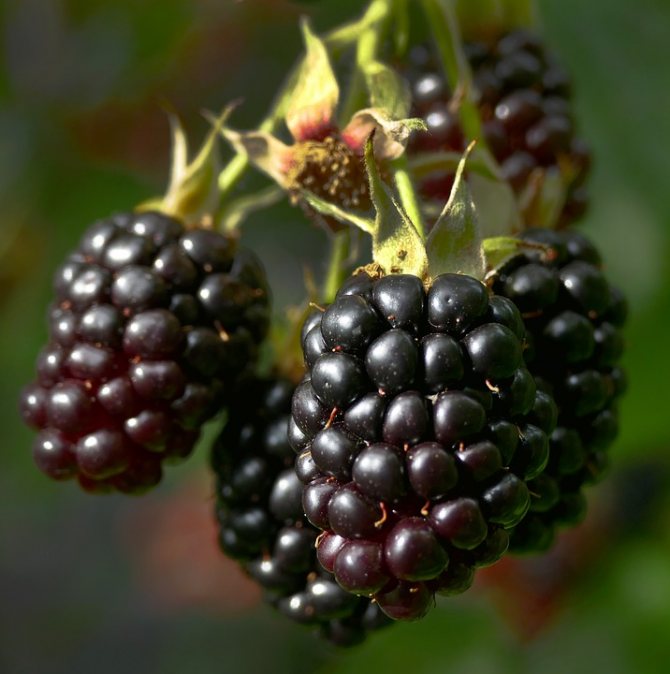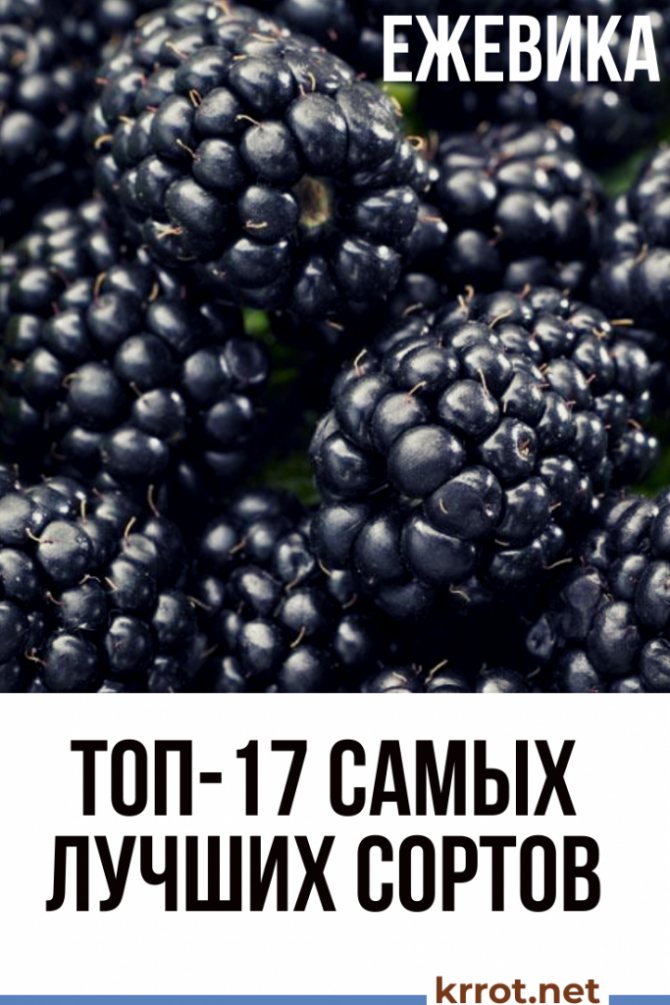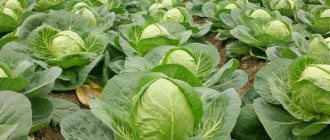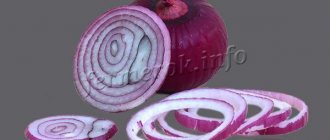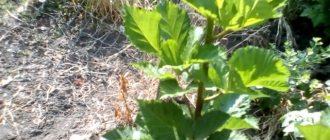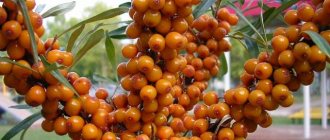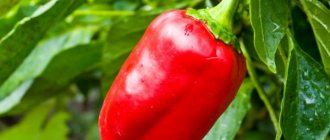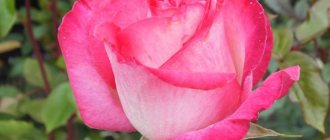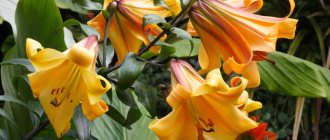Home »Garden and vegetable garden» Garden »Berry bushes
OtherGardenBerry bushes
Vladimir Serchenko
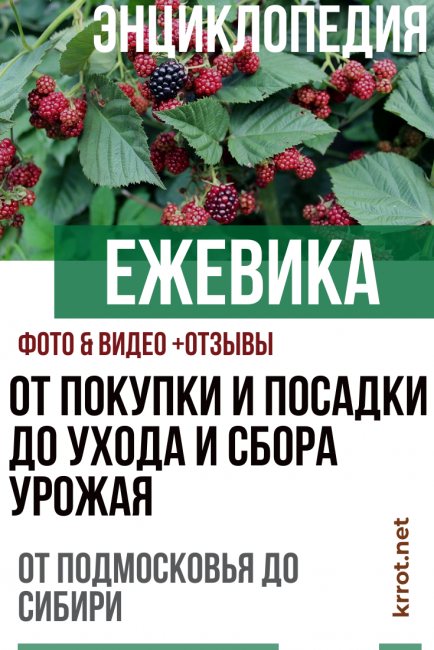
To date, about two hundred varieties of cultivated blackberry varieties have been described. Many gardeners are familiar with blackberries. And in nature it occurs quite often.
See also: Blueberries: a description of the 25 best varieties from early to late ripening. Secrets of agricultural technology and useful properties of berries + Reviews
Description
Let's find out the most important varietal characteristics of Polar blackberries.
Selection
The variety is Polish, belongs to the bushy species. The official year of birth of the variety is 2008. When creating this variety, Polish scientists set themselves the task of breeding fruitful blackberries that do not require winter shelter.
Looking ahead, we note that in most regions of our country it is still better to cover the bush for the winter. In Poland, maybe it is not necessary.
Note that initially this blackberry was intended for industrial cultivation with the aim of further processing and conservation. But thanks to its excellent taste and unpretentiousness, the variety has become popular among amateur gardeners, ordinary summer residents.
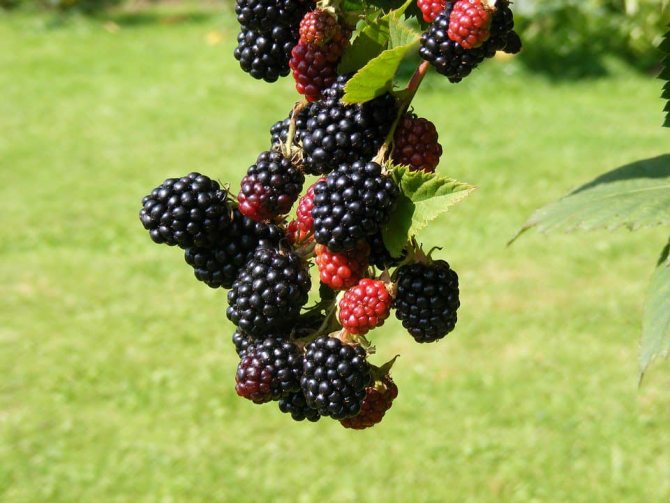

Features of the
The plant boasts drought tolerance. This is important, especially for regions with hot climates. But still, to get a good harvest of juicy berries, you should not forget about watering.
Shelter is required, but only in cool regions, in which it is frosty and with little snow in winter. There is evidence that the plant is capable of tolerating short-term frosts down to -30 degrees.
Flowering is observed in May: early or middle of the month: specific dates depend on the climate of the region.
The plant has excellent immunity: Polar blackberries rarely get sick, pest infestation is also rare. But preventive treatments are still needed, especially when growing crops on an industrial scale.
Ripening time and yield
The berries ripen in July, the variety is recognized as medium early. Full fruiting begins in the third year after planting. Delicious berries are harvested from mid-July until the end of September.
In the middle lane, ripening dates are shifted towards autumn: it turns out to harvest only from the end of July or from the beginning of August.
On average, 3-5 kg of fruits are harvested from one three to five year old bush. With regular and high-quality shelter for the winter, the shrub will bear fruit better, its yield will increase. This fact has been noticed by more than one gardener.
Description of the plant
- The shrub is equipped with erect shoots, reaching 2.5 meters in length in adulthood.
- The ends of the shoots droop.
- An important feature is that the branches of this blackberry do not have thorns. Taking care of the plant and harvesting is therefore much easier.
- Shoots at a young age are bright green, brown over time.
- The foliage is green, beautiful, bright, large.
- A big plus of this variety is also that it practically does not give root growth.
Description of fruits
From large white flowers, over time, the same large, but already black, glossy berries appear. The structure of the fruit is dense, weighing 9-11 grams. An interesting feature: the fruits that ripen first have the greatest weight.
The berries taste very sweet, but not excessively, without sugary. There is even a subtle sourness. This blackberry has no bitterness, which is liked by all plant owners without exception.On a five-point tasting scale, Polar blackberries received 4.5 points.
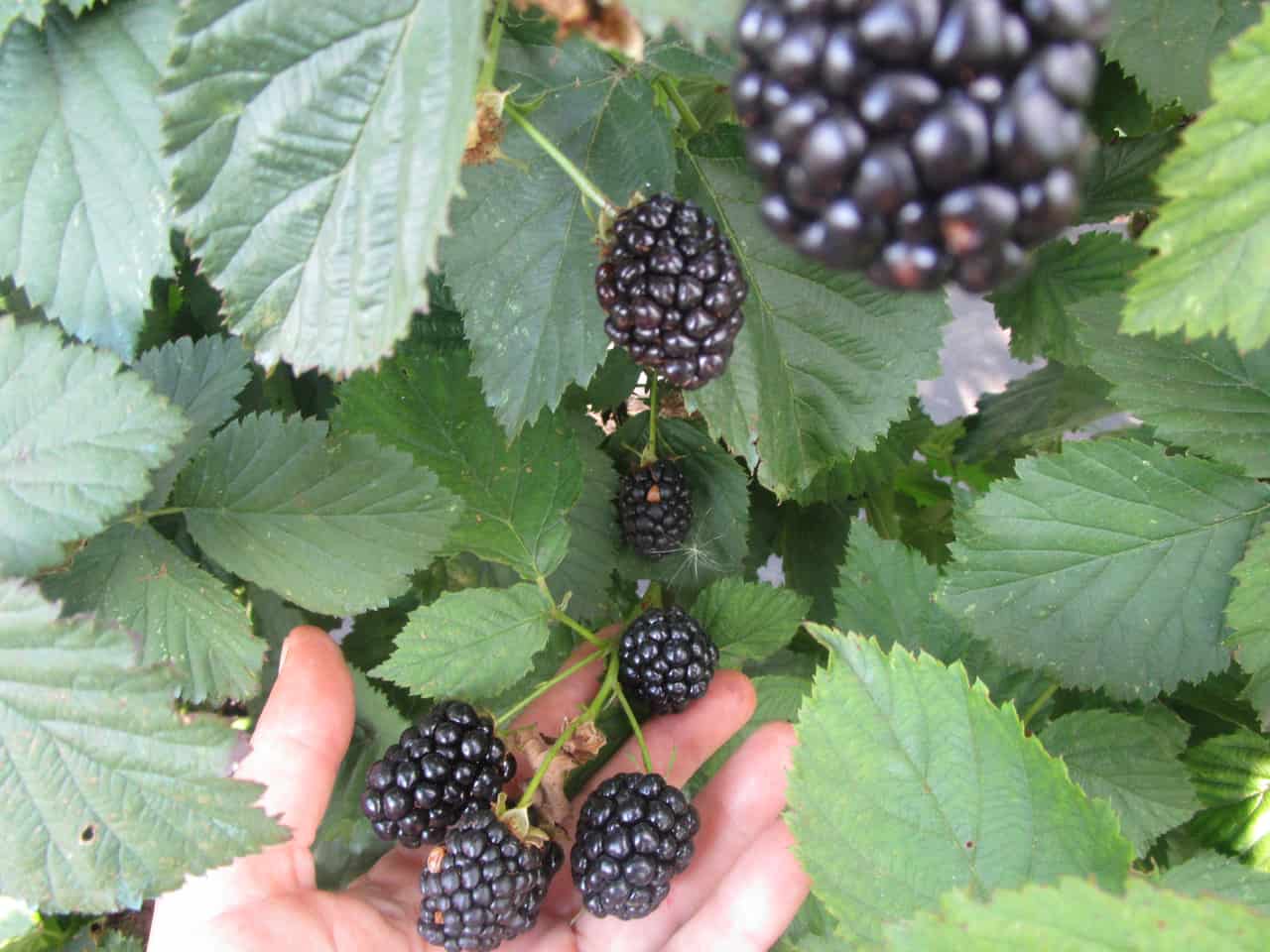

Varieties of garden blackberries
Since several varieties were used to breed varietal berries, perennial shrubs have different structures and types of fruiting. Like their wild ancestors, many varieties have retained their creeping shape. Plants with long, up to several meters shoots are grown on trellises, which allows you to get the highest yield from one bush.
Blackberry bush varieties are more like raspberries. Such specimens bear fruit on two-year-old shoots that retain an erect or semi-lying shape. Plant height reaches 2–2.5 meters and needs pruning.
To simplify the care of the plantings, it was possible to obtain varieties of thornless blackberries. Such varieties are easy to identify already by the name, to which the prefix Thornless is added, that is, "without thorns."
Blackberries have a long growing season. On the one hand, this allows the plant to protect itself from spring frosts and return cold weather. But on the other hand, the harvest ripens late, and in the northern regions the ovaries, without filling, go under the snow. Repaired blackberries, which bear fruit throughout the season, solve the problem.
Today, gardeners have at their disposal many interesting varieties of blackberries, which give a large dessert berry. It remains only to study the photos and descriptions of blackberry varieties and, based on the climatic conditions of the region, choose the right one.
How to plant
Let's get acquainted with the features of planting a blackberry bush.
Timing
The choice of planting time depends on the region of residence of the gardener.
- If it is south, it is best to plant in the fall, after the heat has subsided. But before the onset of the first frost, there should be at least a month's supply of time.
- Planting in the regions of the central part of the country and in the Moscow region should be carried out in the spring, after the ground warms up. It is important to choose a time when there is no longer any danger of recurrent frost.
Site selection
Blackberry Polar prefers to grow in a sunny area, protected from the wind. Please note that this variety does not like waterlogging, therefore, the occurrence of groundwater should be at least one and a half meters.
As for the soil, a slightly acidic loam is the best choice. In addition, a high nutritional value of the substrate is also important for the plant.
Landing procedure
- Before rooting, the roots of a blackberry seedling must be soaked in water for 12 hours.
- The top of the plant is shortened by 15-20 cm.
- In the center of the dug hole, a small mound is formed, on which the plant is placed.
- The roots should be spread over the "slopes" of the mound.
- Sprinkle the seedling with earth, while the root collar is deepened by 1, -5-2 cm.
- The plant is watered, mulched.
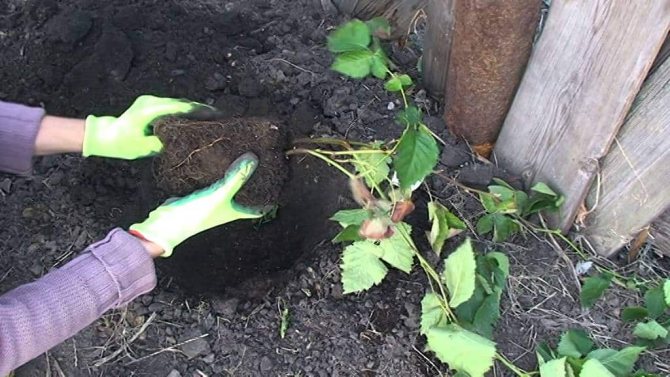

We will learn how to care for the Polar blackberry variety.
Watering
Watering should be done twice a week immediately after planting and until the plant is completely rooted. Abundant moisture will help the seedling take root faster.
In the future, watering is carried out as needed: it is imperative to take into account the degree of soil drying. It is necessary to increase the frequency and volume of water procedures in hot, dry weather.
It is impossible to allow the soil to dry out significantly: this will negatively affect the taste and size of the crop. When in doubt, water a little rather than let the roots dry out.
Garter
This variety needs to be fastened to the support. You can use any form of trellis:
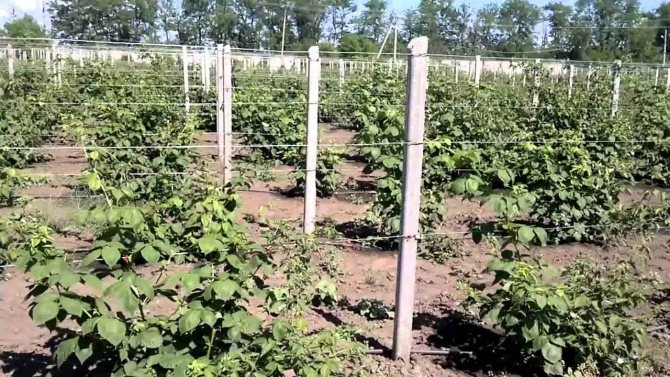

Top dressing
This variety is not particularly demanding for feeding. However, the bush will be glad for additional nutrition.
- In the spring, it is recommended to add nitrogen, which will help the plant to grow faster with new shoots.
- When the plant begins to bloom, apply a compound fertilizer to help a lot of fruit set.
- After harvesting the berries, feed the blackberries with potassium monophosphate, which contains two essential plant minerals.
Plant life cycle, ability to regenerate
With age, subsequently aging, the underground part of the plant loses its ability to recover, the formation of new shoots stops and the plant dies... The plant lives as long as the underground rhizome is capable of producing new replacement shoots.
All representatives of blackberries have a large number of adventitious buds on additional underground rhizomes, from which stems are formed, which can be used for propagation, or left for fruiting in a row strip.
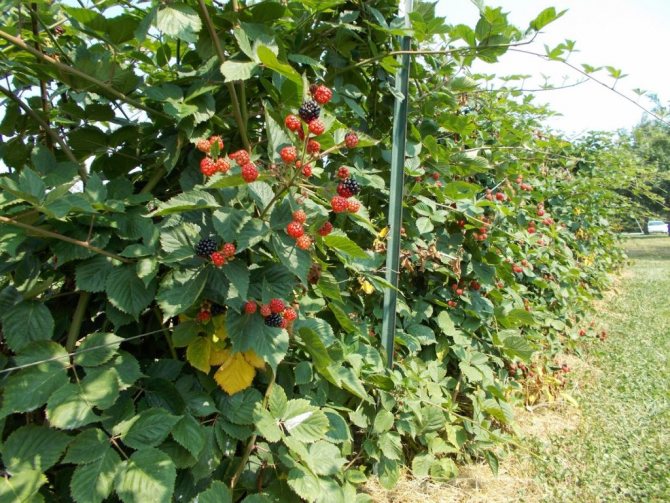

Blackberry plantations
Deeply placed old roots form few root processes. A large number of root shoots grow on light, rich soils in young plantations.
Already in the third year after planting, the root shoots sprout at a distance of 100-120 cm from the bush.
- Blackberry stems have a two-year development cycle, and the underground rhizome lives for more than one year.
- Depending on the power of growth and the method of cultivation, during the first season, blackberry shoots reach 1.7 - 3.2 meters in height and practically do not branch out.
- The taller and thicker the stems grow in the current year, the higher the harvest is expected for them next season.
- Sometimes it happens that strong shoots grow too quickly due to moisture and fertilizers, such shoots do not ripen in time and freeze in winter, which negatively affects their further productivity.
- Annual spring shoots, which are most often formed from replacement buds on the underground rhizome, do not grow in height and do not thicken the next year, and fruit branches with leaves and inflorescences develop from their buds.
- After the fruits ripen, the fruiting stems gradually die off, in late autumn they become completely dry.
- This does not need to be brought up, since they use nutrients and moisture that do not benefit the next year's harvest. Therefore, after the end of the collection of berries, such stems must be removed from the plantings completely.
In the second half of summer, summer shoots grow, which have no economic value. They must be removed along with the stems that have borne this year.
back to menu ↑
Read also: TOP-22 of the most popular and non-whimsical ornamental shrubs for a summer residence or a private house (90 Photos & Video) + Reviews
Testimonials
How gardeners say about this berry variety, we will find out further.
Maria Viktorovna, Smolensk:
I am retired, so I spend all summer at the dacha. I also grow fruit crops, berries and vegetables. When I was in the nursery for the last time, they offered me to buy saplings of varietal blackberry Polar of Polish origin, they praised them very much.
I had never dealt with blackberries before, but after learning that the plant had no thorns, I agreed to buy. My blackberry has been growing for the fourth year already, it has already managed to please with the harvest. And having collected the first berries, I finally believed in this variety: the fruits were so large, sweet and tasty that they were simply surprising. Now I will never give up on this shrub, maybe I will plant a few more.
Blackberries grow in my country house, besides, there are several varieties. Now my favorite variety is Polar: perhaps, for the sake of it, I will give up other species. I really like the berries - they are so juicy and large that my whole family adores them, including my little grandchildren. The only thing is that you definitely need shelter, although the variety is positioned as non-covering. Our climate near Moscow is not so warm after all. More cons were not noticed.
Blackberry variety Polar: description, photos, reviews, planting and care secrets
Blackberry hybrid Polar belongs to industrial varieties, but in recent years its popularity has been growing among private owners.First of all, this is due to excellent stable fruiting, not demanding care and large tasty berries. Agree, it is a pleasure to grow a berry crop that yields an excellent harvest at low cost.
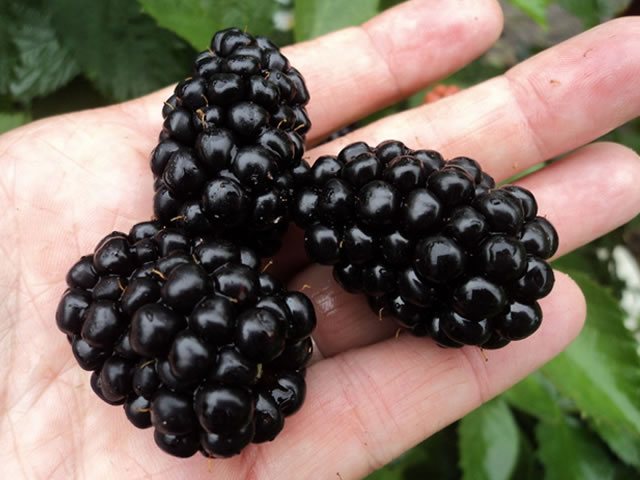

Reproduction and disease resistance
Since it has been established that the Polar blackberry after 2-3 years loses its former fruiting strength, gardeners recommend starting the transplantation of young seedlings to a new place.
Most often, reproduction occurs with the tops of the shoots. If the soil is fertilized, then the trimmings can be accepted without problems.
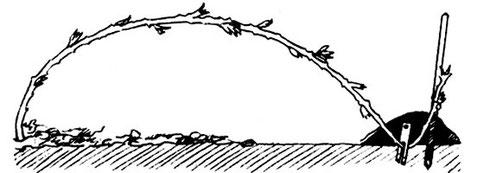

Reproduction using the tops of the shoots
Gardeners claim that Polar blackberries have unique resistance to various diseases.
Description of the variety
Blackberry Polar is a shrub vine of the Rosaceae family, obtained by breeders of the Institute of Horticulture in Brzezno (Poland) in 2008.
The variety is characterized by the following external features:
- erect, massive and thornless shoots, reaching a height of 2.7 m (refers to kumaniks);
- leaves are compound, three-lobed, toothed, rough, light green in color;
- lignified shoots are brown, young shoots are bright green;
- the root system is large and lies deep - up to 1.5 m;
- flowering occurs in early May, the flowers are white;
- lined, oval-shaped, deep black berries appear from mid-July. Fruiting ends in September. Fruit weight 9-11 g;
- berries are sweet with a light refreshing shade and slight sourness, without astringency;
- in terms of physical characteristics, the fruits are elastic, have a moderate density.
- The varietal feature of the Polar blackberry is the drooping tips of the branches.
The variety belongs to medium early, has an excellent yield. Young bushes (up to 3 years old) do not have a high return, but starting from the 4th year each bush brings up to 5 kg. berries per season. Fruiting is stable and durable. The berries are perfectly stored, canned or frozen.
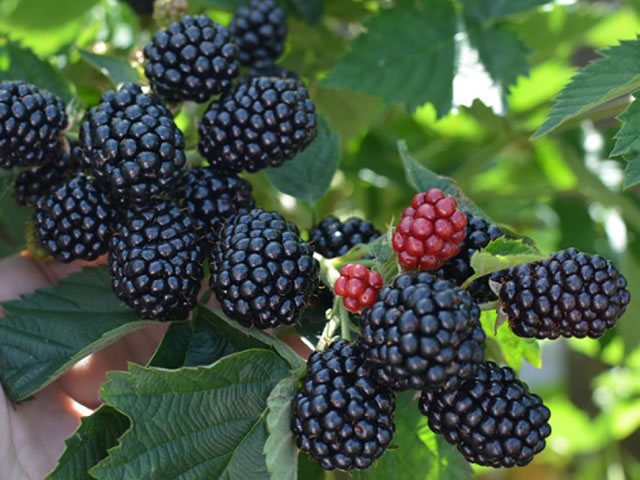

Brief description (pros, cons)
Due to its varietal characteristics, the Polar blackberry grows well in the southern and middle latitudes. Suitable for both industrial cultivation and home gardens.
Benefits of the variety
- Berries of high taste with a pronounced blackberry aroma. Tasting score 4.5 points.
- Excellent yield.
- Keeping quality and transportability: juice does not flow out of overripe berries. Convenient mechanized cleaning and collection in containers.
- Quite good winter hardiness: the shrub can withstand temperatures up to -24 gr.
- Resistance to pests and diseases.
- The absence of thorns greatly facilitates plant care and harvesting.
- Forms a small amount of root growth.
- Unpretentiousness.
- Due to the late flowering of the Polar blackberry, temperature extremes and recurrent frosts are avoided.
- The possibility of thickened landings.
Disadvantages of the variety
- The need for shelter for the winter in areas with little snowy winters and a drop in temperature to -30 degrees.
- Thick stems are difficult to tilt towards the ground for cover.
Note: Since the flower buds of the Polar blackberry do not freeze, the branches on the bushes are simply strewn with fruits, which makes even the shoots appear black.
Landing
A sunny place and a well-warmed area are suitable for planting. The yield will be significantly higher if the site is lit throughout the day. Lowlands and areas with a close location of groundwater will not work, since the root system goes deep into the soil and will get wet. Also not suitable are places blown by through winds.
Blackberries thrive on sandy or loamy soil with neutral acidity. With highly clayey soil, sand and peat are added to it, and the sandy soil is mixed with clay and humus.On acidic soils, liming is carried out, and ash is also introduced.
Sequence of actions for landing:
- The site is freed from weeds, dug up, on poor soils - fertilized.
- Prepare planting holes 40 × 40 × 40 cm in size. Maintain a gap between holes up to 1.2 m, between rows: 2.0-2.5 m.
- Drainage from expanded clay, broken brick, coarse sand is placed at the bottom of the hole.
- A fertile mixture of compost, ash, garden soil is poured on top. From mineral fertilizers it is useful to add superphosphate and potassium salt. The composition is mixed.
- The hole is poured with water and the water is allowed to be absorbed.
- The stalk is placed in the hole, spreading the roots and filling them with a fertile mixture. The root collar deepens slightly (no more than 1-2 cm).
- The earthen layer in the near-trunk circle is slightly trampled and covered with mulch.
Growing in a personal plot
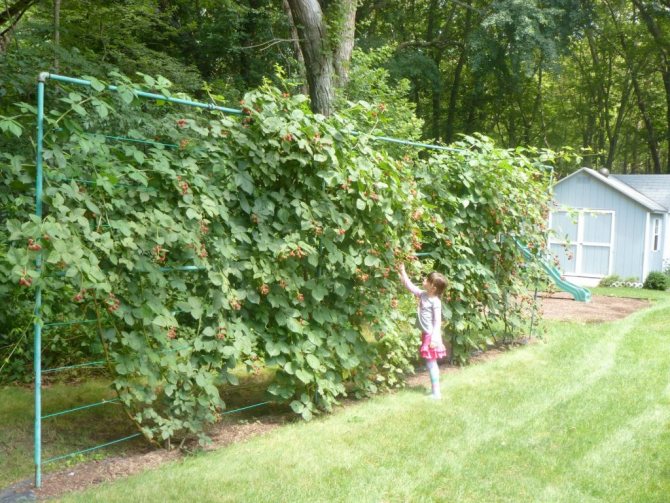

Blackberries on a trellis
- During the period when fruits appear, cultivated blackberries are quite demanding on the presence of moisture in the ground. With its lack of berries, there are few berries, they are dry, and often crumble without ripening.
- At the same time, the plant does not tolerate waterlogging. Stagnant water is especially contraindicated for blackberries.
- For an adult bush, a sufficiently long stay on waterlogged soil may not become destructive. But the layers will almost certainly die, as their roots are ripped out.
- The plant is quite drought tolerant. This is due to deeper roots than raspberries.
- The root system can go to a depth of more than one and a half meters.
- It must be borne in mind that blackberries love the sun. It can develop in a small shade, but both the yield and the sugar content of the berries suffer greatly from this.
When planting bushes, it is necessary to ensure good drainage of the soil and an abundance of sun. The rest of the blackberry bushes are not too whimsical. But do not forget about the small but extremely tenacious spikes. Place the blackberries so that they are easy to pick.
Berries blackberries are good in any form. Jam is made from it, ground with sugar. Dried berries make an amazing tea in winter. And fresh blackberries, perhaps, are no worse than even raspberries.
back to menu ↑
See also: Dogwood: description, planting in the open field, care, reproduction, possible diseases - a plant for all occasions (50+ Photos & Videos) + Reviews
Growing and care
The description of the variety and its characteristics correspond to the reviews of gardeners. When creating the variety, Polish breeders took care of its low maintenance requirements, which makes summer gardening much easier.
Growing on trellises allows you to get high yields, all other things being equal. For northern regions, a fan garter with a gradual inclination of the branches to the ground is preferable, so it will be easier for the plant to bend to the ground in autumn.
Watering
Blackberry Polar is highly drought tolerant. She needs abundant and regular watering, mainly after planting. At this time, watering is very important, thanks to it, the plant will get stronger and grow faster. After watering, it is imperative to loosen and mulch the trunk circle.
If the summers are hot and dry, then watering is also necessary. You can pour water into the near-trunk circle, you can make irrigation grooves along the rows. The Polar variety can do without moisture for a long time, but with prolonged drought, the quality of the berries is lost, which become small, their juiciness disappears.
Pruning
After the end of fruiting, the shoots of the second year are pruned. It is important to carry out this procedure on time, then the wood on the shoots of the first year will receive more nutrients and will get stronger before frost. Usually, 4-7 lashes are left for each bush for subsequent growth and the return of the next year's harvest.
A three-year-old shoot of the Polar variety can reach a diameter of 3 cm!
In the summer, the lateral shoots are pinched, when they reach a length of 40-45 cm. So they branch better and a new crop is formed on additional branches.Sick, frozen, broken, growing "crooked" processes are cut off both in the spring and throughout the year.
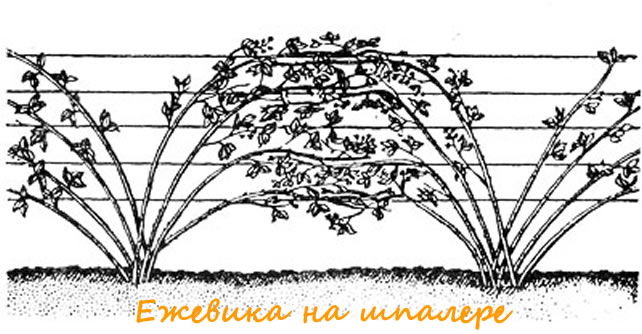

Top dressing
Blackberries of the Polar variety have a positive attitude towards top dressing, but they can do without them. If the gardener does not have the opportunity to apply fertilizers, then he will also receive a crop, just its volume will be less.
Adding dressings for blackberries:
- In the spring, nitrogen fertilizers are applied, which contribute to the growth of green mass and are necessary for the bush to begin to grow actively. For each bush, you will need 1 bucket of rotted manure, ½ cup of superphosphate and ¼ cup of ammonium nitrate.
- During flowering, complex care with macro and microelements in the composition is useful.
- After fruiting, potassium monophosphate is important as top dressing, nitrogen fertilizers are not applied at this time, they will stimulate the growth of shoots, which will negatively affect winter hardiness.
During the period of growth and fruiting, you can make any organic compounds from fermented grass, mullein, bird droppings, ash. Additional food during this time will definitely not hurt.


Treatment against diseases and pests
Blackberries are practically not affected by pests and diseases. During the season, you can carry out two preventive treatments with copper sulfate and phytosporin to fully guarantee the health of the plant.
Note: It is undesirable to plant strawberries and raspberries near blackberries, since they are representatives of the same family. The close presence of nightshades also has a negative effect. The remoteness of these crops should be at least 10 m.
Preparing for winter
The Polar variety was created as non-covering. But on the territory of our country, even in the southern regions, it is better to poke the root, and wrap the whips on the trellis with agrofibre. In the northern regions, it is necessary to remove the branches from the trellises and pin them to the ground. Then create a shelter by covering the whips with straw, spruce branches, agrofibre.
Polar belongs to winter-hardy varieties, slightly inferior in this indicator to another popular blackberry variety Agavam.
Without shelter in warm winters, the plant will not die, but flower buds can freeze through it, which will lead to a loss of yield by 3-5 times.
Growth and fruiting
The development cycle of blackberry shoots is two years old, because it is the closest relative of raspberries. The first year is devoted to shoot growth and bud formation. In the second year, the shoot bears fruit and dies off.
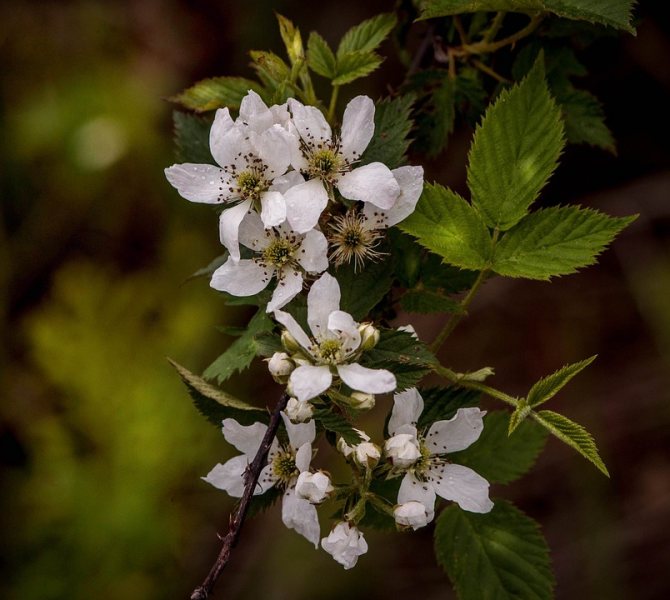

Blackberries bloom quite late, not earlier than June
Blackberries bear fruit very abundantly. The dark purple, red or black fruits are similar in shape to those of raspberries.
In principle, there are two forms of blackberries - kumanik (it is it that is most often called blackberries) has erect shoots, they are creeping in dewberries.
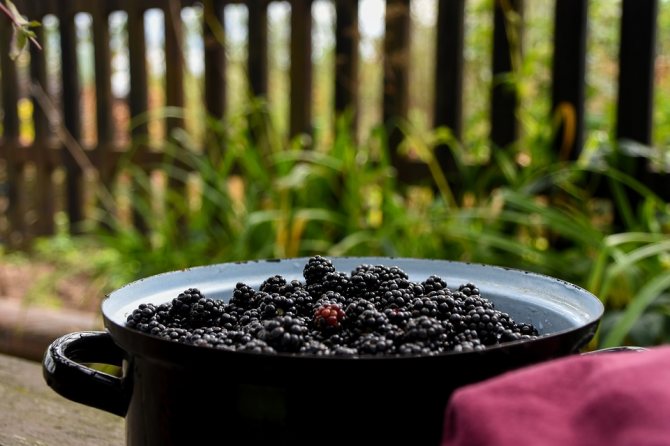

Blackberries bear fruit very abundantly.
Transitional forms can often be found. In the garden, prickly blackberries are placed on a trellis in a single or double row planting. It is very convenient to place blackberries, for example, along a fence, near the walls of outbuildings, etc.
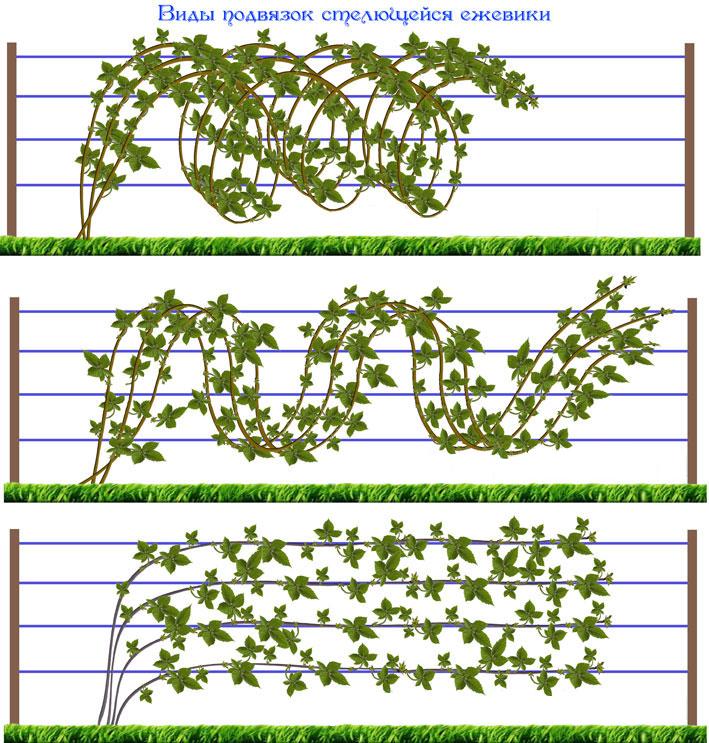

In the garden, prickly blackberries are placed on a trellis
The distance between plants is from 3/4 to 1 meter. Up to 2 meters are left between the rows. Stems of the second year (fruiting) are fixed on the upper row of wire, young ones - on the lower one.
back to menu ↑
See also: 10 varieties of bamboo for growing in Russia: description, home care and its features, reproduction + Reviews
Reproduction
Blackberries of the Polar variety are propagated by apical shoots (pulping):
- the shoot of the first year is pruned by 2-3 cm;
- departing 10 cm from the top, leaves are cut off from the shoot;
- the shoot is tilted to the ground and the part without leaves (15-20 cm) is sprinkled and fixed with hairpins;
- the place of contact with the soil is periodically watered.
Rooting will take place the next year, after which the seedling is separated from the mother plant and planted in a "school" or in a permanent place.
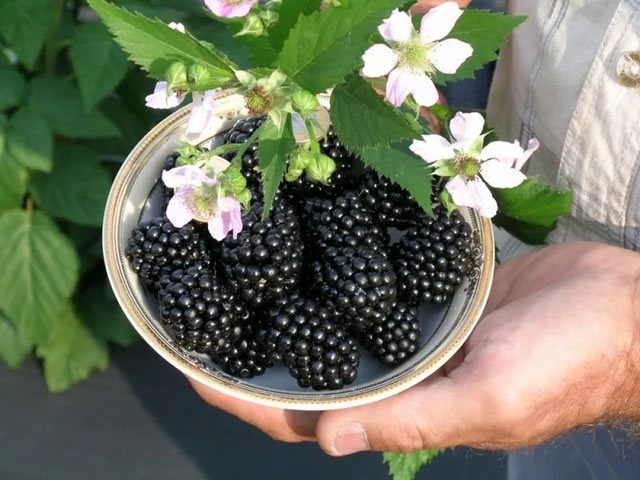

Pests and diseases
- Of the various pests, which, by the way, are few in blackberries, the main place is occupied by parasitic fungi, which develop in the form of rust on young shoots and leaves, and the latter are covered with grayish brown spots.
- The affected leaves dry out over time and fall off, significantly weakening the development of the plant.
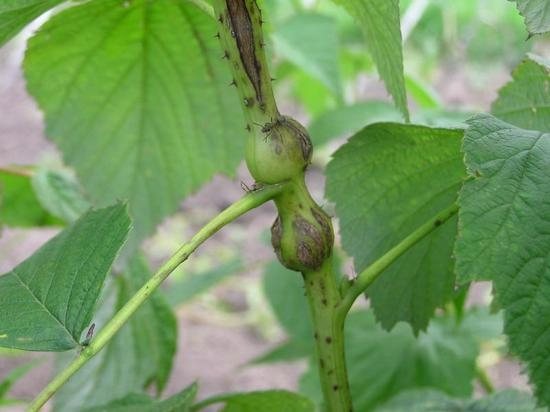

Shoots damaged by a walnut fly
- Common orange rust is one of the most common types of fungal parasites.
- All such diseases can be cured by spraying with Bordeaux liquid.
- The first spraying is done before bud break; the second - when the young shoots reach a length of 15-20 centimeters, and the third - at the end of the collection of berries and removing the cutting of fruiting shoots.
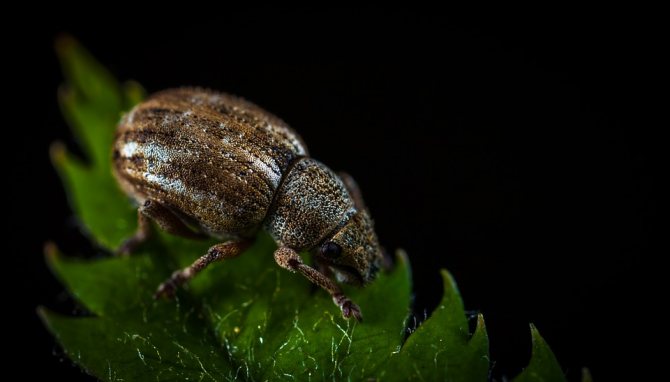

Weevil on a blackberry leaf
- Among the insects, some borers are harmful and, mainly, the nut fly, which lays eggs in the peel of the shoot, from which the latter swells in the place of damage in the form of an influx;
- Such a shoot bears fruit of poor quality or often does not bear fruit and dies off. The fight against this pest consists in cutting and burning damaged shoots.
See also: Dieffenbachia: a description of 12 varieties for growing at home, features of care, transplantation and reproduction + Reviews
Testimonials
I have been growing Polar blackberries for the seventh year. I like the variety for its large, dense berries. The berries are very sweet, but there is a slight sourness, so the taste is very pleasant, not cloying. I will attribute the shrub to unpretentious plants. I don't fertilize and water especially. One year I observed a large number of yellow leaves, read the literature, it turned out that this is chlorosis, which is caused by a lack of iron. I sprayed it with a chelate complex and the plant turned green, it began to grow even more intensively.
I grow several varieties of blackberries. In terms of yield, I like Chester the most, and Polar berries taste best. I want to draw the attention of all gardeners to the difference in the winter hardiness of the bush and its flower buds. The bush can survive frosts and up to -30 gr. and you will consider that everything is fine and be content with a very modest result. Why will the result be modest? Because the flower buds are frozen, and in this case, the yield may fall 5 or more times. Blackberry in the Conditions of Russia, if you do not take into account the Crimea and the Krasnodar Territory, must be covered for the winter. There are problems with Polar's shelter, because the plant belongs to kumaniks, which means it is erect, and even branches of 2-3.5 cm in diameter. Therefore, my advice is to start forming a bush on a trellis while the shoots are still very small. Tie up initially at an angle of 45 degrees. then, as you grow, bend down even more. You can pinch the shoot when it reaches a height of 60 cm and form the growing lateral branches horizontally. Growing blackberries on a trellis cannot be attributed to simple gardening activities, but the result will exceed all your expectations. I collected both 3 and 5 kg from each bush, and from Chester in one season I collected 9 kg. fruits.
Each gardener has his own preferences and he chooses a variety based on their personal preferences. But the Polar blackberry will not disappoint lovers of this delicious berry. Only northerners will have a harder time growing it, since the variety does not like frosts.
Basic principles of plant care
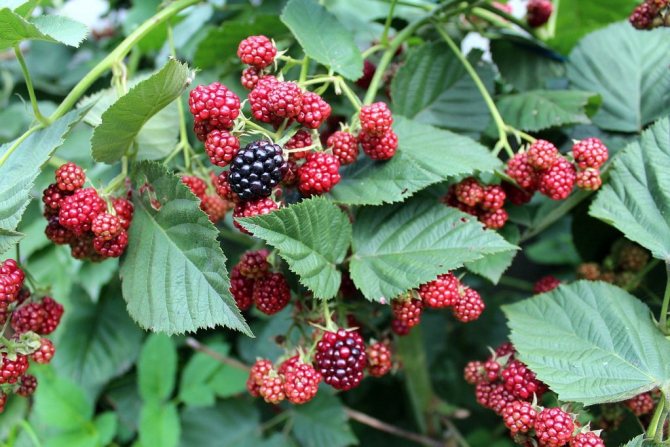

Blackberry bush
1 The plant winters better when the upper part of the stems is removed. The lateral branches that appear in the spring are shortened, leaving 25-40 cm. In winter, the dewdrop must be covered.
2 Closer to spring, the bushes are opened to ventilate. In a warm winter, they are constantly ventilated by opening the ends of the cover.
3In case of improper ventilation, frost burns of the plant and other diseases are possible.
4 Erect and mixed forms are sometimes forced to creep, bending down replacement stems that have reached a length of half a meter. Moreover, it is not worthwhile to strongly oppress the stem, over time it will bend more itself.
5 After pinching a neatly bent stem to force it to develop parallel to the ground, pinch it immediately. This forces the side branches to actively develop. On a young shoot, all buds are flowering.
6Thus, it is possible to create a more compact bush, characterized by high productivity.
7 Immediately after collecting the last berries, the old shoots are removed to allow the young to grow stronger.
8 The root system has lived for more than one year, it is represented by a powerful rhizome (underground stem) and additional roots that grow from underground stems.
9 Basically, all roots are located in the soil up to 45 centimeters, some roots reach 90 cm and deeper. A strong root system promotes the formation of strong shoots, ensures their good growth and yield.
back to menu ↑
See also: Indoor flower "Bride and groom" or campanula: description, care, reproduction and possible diseases (50 Photos) + Reviews
Characteristics and description of the Polar blackberry
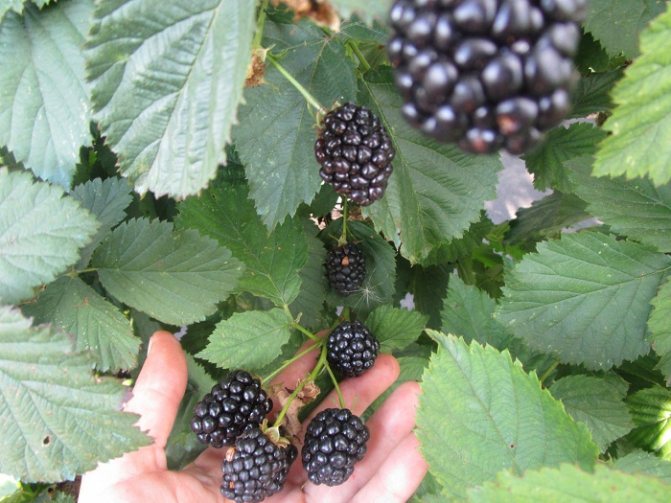

A large harvest without additional hassle is the dream of any summer resident! The greatest demand is for varieties and hybrids of various horticultural crops that do not require special care and are resistant to all sorts of negative factors. Fortunately, thanks to the painstaking work of breeders, we have a lot to choose from.
Let's get acquainted with a very unpretentious blackberry variety called Polar. It was bred in Poland back in 2008. The gardeners of our country had enough time to try it and share their cultivation experience.
Description and characteristics of Polar blackberry
Shoots grow up to 2, 7 meters in height, they are straight, powerful, there are no thorns. Very little overgrowth. The variety can be grown in all regions of Russia, except for the coldest ones. Polar tolerates frosts up to 24-25 degrees without loss, provided that the winters are snowy. Freezing of flower buds is not observed. Disease and pest resistance of the crop is excellent.
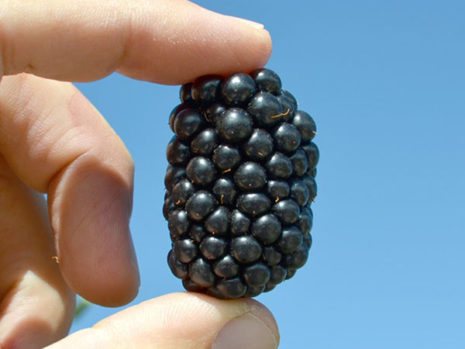

The berries are large, oval (uniform), black and shiny, weighing up to 11 grams. Dessert taste, sweet with a very light, refreshing acidity, no astringency. The aroma is intense, the bones are small. The pulp is firm and pleasant. The berries are universal, they tolerate transportation well, and are suitable for growing for sale. The leaves of the plant are used to make homemade teas.
A medium-early ripening variety, the first berries can be picked from mid-July in warm regions and from August in temperate climates. The fruiting period is extended, the fruits ripen until the first half of September. The yield is very high, the fruit-bearing branches are usually strewn with flowers and berries. In the first few years of cultivation, the bush gives up to 2 kilograms of fruit. From 5 years of age, the yield increases to 5-6 kilograms per plant.
It is worth separately describing the incredible decorative effect of the bush during mass flowering. Tall, strong stems by this moment are covered with jagged, dark green leaves, and lush fruit-bearing branches are strewn with large, white flowers with a delicate aroma - a feast for the eyes!
Growing features
The variety is undemanding to growing conditions, takes root in any soil, but in order to get a good harvest, you need to follow a number of important recommendations:
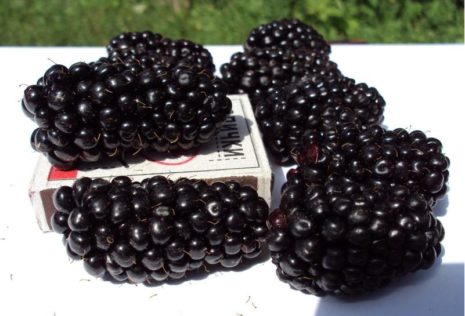

- In order for the plant to take root well, planting is carried out from March to mid-April. If you got the seedling in September or October, feel free to plant it, but for the winter you need to cover the blackberry well.
- The site is selected windless, sunny, blackberries do not like excessive moisture, the plant is more comfortable on well-drained loams.
- The holes are prepared so that the root of the seedling fits completely, the root collar should be at ground level. Drainage material is laid at the bottom of the pit, and a mixture of 5 kg of compost, 35 grams of superphosphate, 15 grams of potassium salt, a handful of wood ash and garden soil is prepared for filling.
- For the winter, even if mild winters prevail in the region, it is better to cover the Polar blackberries.If you neglect this procedure, the yield is noticeably reduced. It is necessary to prepare the plant for shelter as early as possible, preferably immediately after the end of the fruiting period. At this time, the stems are still flexible, closer to winter they stiffen;
- Blackberries need watering during drought and fertilizing throughout the season. It is necessary to moisten the bushes moderately, avoiding waterlogging of the soil. The first fertilization session is carried out in early spring, the second during flowering, and the last when all the berries are ripe.
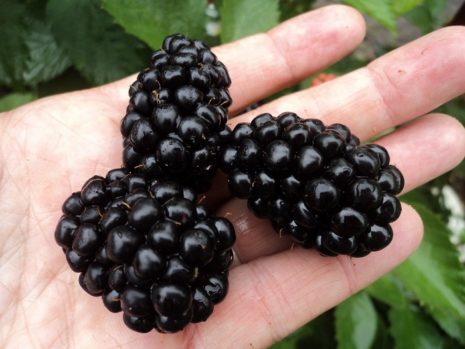

The Polar blackberry begins to bear fruit in the second year after planting, and after another 2 years it can be propagated. For this, the upper parts of the shoots and root suckers are suitable.
Pruning
The procedure should be carried out twice a season. In the spring, all the frozen parts of the bush are removed, and in the fall, you can carry out molding pruning at your discretion. In general, some gardeners do not cut the bush, but tie long stems to strong trellises as they grow, in the fall they are untied and covered for the winter.
Selection of seedlings
The homeland of the Polar blackberry is Poland, so it is very difficult to find pure-bred seedlings here. And if we take into account the enviable characteristics of this berry, the number of those who want to sell the most common variety, attributing the proud name “Polar” to it, doubles.
In order not to be deceived, when buying, ask the seller to present all the necessary documents and certificates. Better yet, buy such plants at exhibitions, they are often held in botanical gardens and at agricultural fairs. Be careful, there are no thorns on the Polar blackberry shoots.
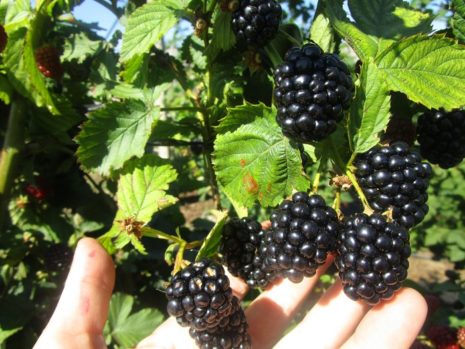

Also, when choosing planting material, you should carefully examine the plant. Seedlings are sold with both open and closed root systems. The stems should be free of any damage or signs of disease, and the root should be strong and developed. Buy only the best specimens.
Advantages and disadvantages
Blackberry Polar is rightfully considered one of the best among the numerous domestic and foreign varieties of berries. The plant has no disadvantages at all, if only the need for a winter shelter. But then it's up to you whether to sacrifice the harvest! Let's move on to the advantages of the variety, and there are many of them, we will highlight the main ones:
- undemanding and ease of cultivation;
- lack of thorns;
- large-fruited, good taste and rich vitamin composition of berries;
- universal purpose of fruits, transportability and keeping quality;
- winter hardiness;
- excellent immunity to all diseases and crop pests.
The positive aspects of the Polar blackberry can go on to describe for a long time. And how many flattering words about the variety are written by gardeners who have tried to grow this berry. If you happen to come across a seedling, be sure to purchase it, you will not regret it!
Blackberry Thornless Evergreen
Thornless Evergreen, a thornless variety of blackberries, was obtained thanks to a noted natural mutation of dissected blackberries. As a result, European and American farmers at the beginning of the last century received an evergreen plant with excellent yields, moreover, without thorns.
Although the 3-gram berries of the blackberry variety shown in the photo are inferior in size and weight to most of the new varieties, their number on the brush is unmatched. In one inflorescence there can be up to 70 ovaries, which, after ripening, acquire a bluish-black color, a delicate aroma and a pleasant sweet and sour taste.
The plant has many advantages, including yield, lack of thorns, frost resistance and the ability to transport berries. The main disadvantage, in addition to the small mass of fruits, is the large blackberry seeds Evergreen Thornless.
Testimonials
Elena. I like this variety very much, it does not require almost any attention to itself, it develops quickly and consistently gives good yields. I live in Krasnodar, and I still cover the bushes for the winter. To make it more convenient, we drove pegs with loops into the ground, bend the stems and fasten them with loops. I feed only in spring and autumn.For the third season, I have been collecting at least 5 kilograms of delicious and very large berries, they go well fresh, in desserts and spins. When frozen, the fruit does not lose its taste.
Dmitriy. I grow berries for sale. Basically, varieties with good commercial qualities of fruits require constant attention. Polar in this sense is a very convenient option, the care of this blackberry is minimal, and the results are always excellent. The variety is also in great demand among buyers, sometimes they even ask to sell several seedlings. I advise you to grow Polar only in warm and sunny areas, otherwise the berries will be dryish and the taste will be more sour.
Sources:
Harvesting and storage
Polar, although considered to be a stable and transportable variety, is still a blackberry. The fruits of this culture, like raspberries, are not suitable for long-term storage at all.
Important! The most favorable conditions for storing blackberries are as follows: air temperature - 0 ... + 2 ° С, relative humidity - 85
–
90%.
However, knowing about some simple rules, and observing them, you can maximize the shelf life of blackberries:
- the berries must be removed from the branch with a part of the stalk;
- when picking fruits, you should touch them with your hands as little as possible - the skin of the berries is very delicate and can be damaged by the slightest touch;
- you need to collect berries in this way: with one hand (non-working), fix a branch with berries, open your palm with the other, bring it under the fruit. Use your thumb and middle fingers to pinch off the stem 1–1.5 cm above the berry. Thus, pick up 5-6 berries in the palm of your hand and place them neatly in a collection container;
- berries without stalkshaving surface damage or signs of disease to the total weight of the crop;
- for collection, use veneer baskets, box bodies, draped tuesques. In such containers, 2–2.5 kg are collected. In the event that it is planned to transport containers with a crop in several tiers, the container is filled no more than 75–80% of its volume;
- for short-term storage of the crop, you can use the cellar, basement or refrigerator, so blackberries can be kept fresh for up to 5-7 days;
- for long-term storage of blackberries, berries are processed or frozen. To freeze blackberries, they are carefully washed, dried, laid out on a pallet in one layer and placed in the freezer. If there are several freezers in the refrigerator, first put in the one that is designed for quick freezing. After 5-6 hours, the berries can be transferred to a regular freezer.
